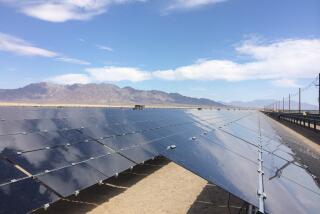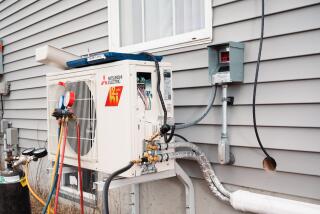THE GREENHOUSE DOWN TO EARTH
PLAINFIELD, N.H. — To the proponents of nuclear power, this year’s drought is one of the best things that could have happened.
Their logic goes like this. The drought is widely perceived to be a first sign of the greenhouse effect--the global warming caused by a buildup of atmospheric pollutants. Primary among those pollutants is carbon dioxide, produced by the burning of coal, oil and gas. Nuclear power produces no carbon dioxide. Therefore, to prevent more and worse droughts, sea-level rises, floods and other climatic horrors, we should nuclearize in a big way.
The media have been captivated by this reasoning; recent news-magazine pieces on the greenhouse effect cited nuclear power as the only major energy source that might replace fossil-fuel plants. The problem with this apparently obvious conclusion is that, like many apparently obvious conclusions, it doesn’t hold up when you run out the numbers. What does add up, rather than fission, is efficiency of design--a solution that is at once cheaper and more all-inclusive than nuclear energy.
Bill Keepin and Gregory Kats, energy analysts at Rocky Mountain Institute in Old Snowmass, Colo., have figured out exactly what it would take for nuclear power to “fill the breach.” They start by supposing that the world’s nations come to an unprecedented agreement to replace all current and future uses for coal with nuclear power, and to accomplish that within 40 years. (They choose coal, rather than oil and gas, because coal is the greatest carbon-emitter of all the fossil fuels, and because nuclear can substitute directly for coal’s major use, which is making electricity.) The two analysts also make the deliberately optimistic assumption that it will take only six years to build each nuclear plant and that the cost will be $1,000 per installed kilowatt capacity (which is the reported current cost in France; in the United States the cost is three times higher).
If the world’s energy demand grows at the top of the range of present forecasts, it will increase 3.5 times between now and 2025. Under that scenario Keepin and Kats calculate that a substitution of nuclear for coal would require bringing on nuclear power approximately equal to all the world’s current energy production. By 2025 the world would need 8,000 large nuclear plants, as opposed to the 350 operating today. New plants would have to come on line at an average rate of one every 1.6 days, at an average cost of $787 billion per year, for 38 years.
Even with this enormous increase in nuclear power, carbon dioxide emissions would grow to be 65% higher than they are now. Greenhouse warming would be rampant, and the drought of ’88 would probably look like a cool spell.
If energy demand goes up at a slower rate--doubling by 2025--and again nuclear energy was systematically substituted for coal, one new nuclear plant would be required every 2.4 days, at a cost of $525 billion annually. To pay for their share of this buildup, Third World nations would have to double their current levels of debt (never mind the problem that no one would lend them that much). There would be 18 times as many nuclear plants as there are today. Carbon dioxide emissions would grow until the turn of the century and then slowly fall, but at all times they would be higher than they are now. The greenhouse effect would go on getting worse.
Why is nuclear power so ineffective in combating greenhouse warming in these calculations? Because it only provides electricity, which accounts for only one-third of fossil-fuel use. Because fossil fuel use accounts for only about half of the greenhouse problem--the rest comes from deforestation and from gases other than carbon dioxide. And because even with generous assumptions about construction times and cost, nuclear generation starts from too low a base and takes too much time and money to take over a major part of world energy production.
The massive buildups of nuclear power assumed in the Keepin and Kats calculations could never really happen. Construction times of U.S. plants are more like 12 years than six. Costs around the world are typically two, three, even five times higher than Keepin and Kats assumed. Even if the managerial capacity were available to construct so many plants so fast, the drain of that much capital into nuclear construction would slow or stop the very economic growth that is assumed to require so much power in the first place. And of course the problems of nuclear power--high cost, intractable and dangerous wastes, evacuation planning, threats to public health, decommissioning, diversion of materials into bombs, vulnerability to terrorism and political unpopularity--all those problems would escalate.
Now for the good news. There are energy scenarios--much easier and cheaper than the high-nuclear ones--that can greatly ameliorate greenhouse warming. They all involve state-of-the-art design to meet energy needs in the most efficient way possible. That doesn’t mean what most people think of as conservation--cold rooms, warm beer and general deprivation. It means efficiency--being smart about warming the rooms and cooling the beer, using the least possible amount of energy for the purpose.
Most efficiency improvements are fast and cheap compared with nuclear power, and unlike nuclear, they apply to every kind of energy use, including transportation. For example, just changing all the light bulbs in America to the most efficient ones now available could shut down at least 40 large coal-fired power plants and save the nation $10 billion a year, an Electric Power Research Institute study concluded. New office buildings could be constructed in the most energy-efficient way at no increased cost, and over 50 years they would save the equivalent of 85 power plants and two Alaska oil pipelines, Keepin and Kats showed. If the average fleet efficiency of U.S. cars doubled from the present 18 miles per gallon to 36, automobile carbon emission could be cut in half (and another half if the fleet reached the 78 m.p.g. of some current five-passenger, full-size test vehicles.) That could be accomplished within one or two turnover times of the fleet--12 to 24 years--at no cost, and there would also be large reductions in urban air pollution and acid rain.
A number of studies have worked out the possible results of a major global commitment to energy efficiency. According to one, the industrialized nations could maintain annual gross-national-product growth rates of 1%-2% per year and still cut per capita energy use in half. The developing countries could sustain substantial rates of economic growth while holding per capita energy demand at nearly today’s rates. The result would be a slight decline in carbon emissions from today’s levels. Add a shift to solar energy, stop deforestation, start reforestation and the greenhouse problem could be reduced dramatically.
Nuclear power advocates will be quick to point out that nuclear could be added to a conservation scenario to reduce carbon emissions even further. Keepin and Kats do a calculation assuming a sixfold expansion of nuclear power by 2025 (a new plant every 7.5 days at an annual cost of $178 billion) in addition to a major commitment to energy efficiency. In that scenario carbon emissions are about half of what they are today. About 38% of that reduction is due to nuclear substitution for coal.
Which is not, however, an argument for adding nuclear power to the list of possible solutions to the global warming problem, primarily because nuclear is so enormously expensive that it drains money away from better options. At current U.S. costs for nuclear and for efficiency, a dollar spent on efficiency displaces nearly seven times as much carbon as a dollar spent on nuclear, does it sooner and does not generate long-lived radioactive wastes.
Since the same dollar can’t be spent twice, it makes much more sense for both environmental and economic reasons to spend it on efficiency. There are so many leaks to plug in the American energy system that efficiency will continue to be our most economic energy option for decades to come--and during that time solar options, whose costs are already dropping rapidly, will probably become competitive with nuclear.
Some people are so bedazzled by nuclear power (usually because their own finances or status depend on it) that they can think of only one answer to any energy problem. They understate the limitations of nuclear energy (cost, long lead times, unwieldiness, dangers and wastes), they assume it can produce miracles without stopping to figure the price of those miracles and they don’t see other choices at all.
Those of us with no particular stake in the nuclear-energy industry need not be so narrow-minded. We don’t have to worry about the false dilemma of nuclear power versus global climate change (live near a nuke or turn your grain belt into a desert--you pick). Other choices are quicker, cheaper, less environmentally destructive--and much easier to live with.
More to Read
Sign up for Essential California
The most important California stories and recommendations in your inbox every morning.
You may occasionally receive promotional content from the Los Angeles Times.










